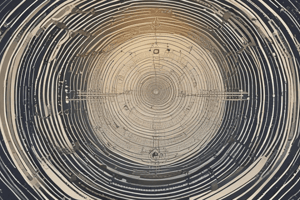Podcast
Questions and Answers
What is another name for the Concentric Circle Model?
What is another name for the Concentric Circle Model?
- The Bull's Eye Model (correct)
- Hoyt Sector Model
- Multi-Nuclei Model
- Central Place Theory
Who proposed the Hoyt Sector Model?
Who proposed the Hoyt Sector Model?
Homer Hoyt
The Multiple Nuclei Model suggests that a city has only one center.
The Multiple Nuclei Model suggests that a city has only one center.
False (B)
In the Latin American Model, where is the high-class residential area typically located?
In the Latin American Model, where is the high-class residential area typically located?
What does the Central Place Theory explain?
What does the Central Place Theory explain?
According to the Bid-Rent theory, how does rent change as distance from the market increases?
According to the Bid-Rent theory, how does rent change as distance from the market increases?
What does the Gravity Model predict?
What does the Gravity Model predict?
What is Rank-Size?
What is Rank-Size?
What is one key assumption of the Weber Model of Industrial Location?
What is one key assumption of the Weber Model of Industrial Location?
What epoch follows the Iron Horse Epoch in Borchert's model?
What epoch follows the Iron Horse Epoch in Borchert's model?
Flashcards
Concentric Circle Model
Concentric Circle Model
Urban land use model illustrating zones around the CBD.
Hoyt Sector Model
Hoyt Sector Model
Urban model suggesting sectors of development extending from the center.
Multiple Nuclei Model
Multiple Nuclei Model
Indicates cities evolve with multiple centers of activity and services.
Central Place Theory
Central Place Theory
Signup and view all the flashcards
Bid-Rent Theory
Bid-Rent Theory
Signup and view all the flashcards
Gravity Model
Gravity Model
Signup and view all the flashcards
Rank-Size Rule
Rank-Size Rule
Signup and view all the flashcards
Weber’s Least Cost Theory
Weber’s Least Cost Theory
Signup and view all the flashcards
Borchert's Epochs of Transportation
Borchert's Epochs of Transportation
Signup and view all the flashcards
Latin American Model
Latin American Model
Signup and view all the flashcards
Study Notes
Concentric Circle Model
- Developed by E.W. Burgess, it illustrates urban land use in concentric rings centered around the Central Business District (CBD).
- Comprises five zones:
- Central Business District
- Wholesale and Light Manufacturing (Zone of Transition)
- Low-Class Residential (Zone of Independent Workers' Homes)
- Medium-Class Residential (Zone of Better Residences)
- High-Class Residential (Commuters Zone).
- Represents an urban version of Von Thunen's land use model, contrasting with the Hoyt sector model and the multiple nuclei model.
Hoyt Sector Model
- Proposed by economist Homer Hoyt in 1939 as a modification of the concentric zone model.
- Suggests cities develop in sectors rather than rings, allowing for outward growth.
- Activities expand in a wedge shape from the center, accommodating various land uses.
Multiple Nuclei Model
- Created by C.D. Harris and E.L. Ullman in 1945, indicating that cities evolve with multiple centers of activity.
- Each nucleus attracts similar industries and services based on shared land-use and financial requirements.
- Neighborhoods develop around these clusters, leading to a diverse urban structure.
- Common examples of nuclei include ports, universities, airports, and parks.
Latin American Model
- Developed by Larry Ford and Ernest Griffin, reflecting Latin American culture and its colonial history.
- Features a prominent plaza and heavy development around the CBD.
- Residential quality declines with distance from the CBD, encompassing:
- A zone of maturity with services and wealthier population.
- A zone of squatter settlements with makeshift housing.
- A transitional zone (in situ accretion) showing signs of development.
- High-class residents often live along the urban spine, while poorer populations are typically found in the suburbs.
Central Place Theory
- Formulated by German geographer Walter Christaller in the 1930s to explain the distribution and organization of human settlements.
- Settlements function as central places that provide services to surrounding areas, arranged in a hexagonal pattern of varying sizes and centrality.
- Key concepts include:
- Threshold: Minimum population needed to support a service.
- Range: Maximum distance people are willing to travel for goods or services.
Bid-Rent Theory
- Introduced by William Alonso, illustrating the relationship between land use and distance from the CBD regarding rent prices.
- Different land uses (commercial, industrial, agricultural, housing) exhibit distinct bid-rent curves.
- Typically, rents decrease as distance from the market increases due to rising transportation costs.
Gravity Model
- Visualizes interaction between places as proportional to the product of their populations, divided by the distance between them (distance decay).
- Large populations generate more potential customers for services, while greater distance reduces the likelihood of interaction.
Rank-Size Rule
- Describes a settlement pattern where the nth largest city is 1/n the population size of the largest city.
- Contrast to the primate city model, where the largest city is disproportionately larger than the second-largest city, often by more than twice its size.
Weber’s Least Cost Theory
- Alfred Weber's model for industrial location emphasizes minimizing three costs: transportation, labor, and agglomeration.
- Assumes geographic uniformity, single product manufacturing, known raw material sources, immobile labor, and flexible transportation routes.
Borchert's Epochs of Transportation
- John Borchert identified four epochs in American metropolitan development based on transportation impact:
- Sail-Wagon Epoch (1790-1830): Low technology and simple transport.
- Iron Horse Epoch (1830-70): Introduction of steam-powered locomotives and rail proliferation.
- Steel-Rail Epoch (1870-1920): Influenced by the Industrial Revolution and expanded hinterlands.
- Auto-Air-Amenity Epoch (1920-70): Emergence of gas-powered vehicles.
- A subsequent High Technology Epoch (1970-present) involves service and information industry growth, not included in Borchert's original model.
Studying That Suits You
Use AI to generate personalized quizzes and flashcards to suit your learning preferences.




